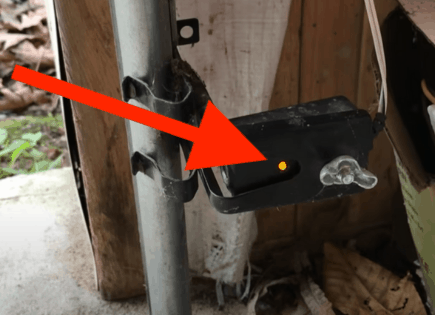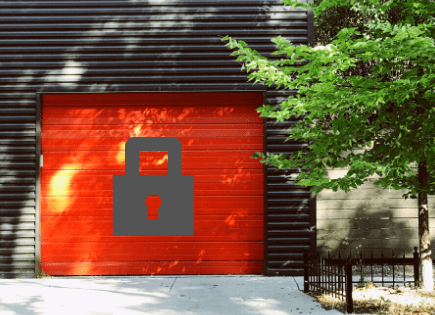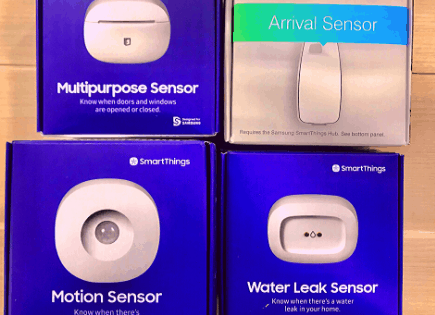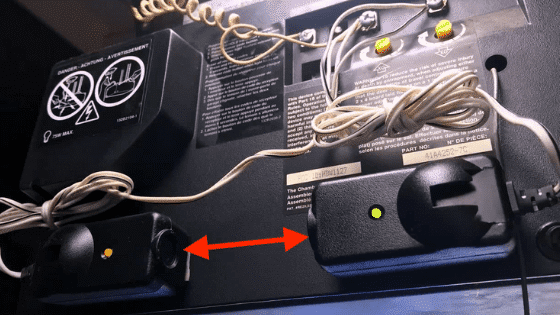
How to Bypass Garage Door Sensor (Warning!)
Is your garage door acting up, preventing you from closing your garage even though there is nothing in front of the sensors? Bypassing the sensor (which is the part that prevents the door from fully closing) may be your best and only option for getting the door shut.
To quickly bypass your garage door sensor, simply hold the open/close button down. This has the effect of “forcing” the garage door to close. If you let go too soon, the sensors will raise the door – so just press and hold until the garage is completely shut!
This guide will teach you everything you need to know about bypassing your garage door (including why you might not want to). Let’s dive in!
 Quick Summary
Quick Summary
If your garage door sensor is malfunctioning, you can temporarily bypass it by holding down the open/close button until the garage door completely shuts. Another approach is to switch your garage door to manual operation by pulling the cord from the motor attached to the ceiling. However, it's crucial to troubleshoot and try fixing the sensor first. Techniques include checking for obstructions, inspecting sensor alignment, cleaning the sensors, checking the wiring, and resetting your garage door opener.
How to Bypass a Garage Door Sensor
If you haven’t already, I really recommend troubleshooting your garage door sensors first (I detail 5 troubleshooting steps to try below). If you can fix your sensors this way, there is no need to bypass them!
After you’re done troubleshooting and unable to find a solution, you can try one of these three methods to bypass your garage door sensor:
1. Press and Hold the Garage Door Button
Go to your garage door opener – the one installed on the wall, not the remote in your car – and hold the button down.
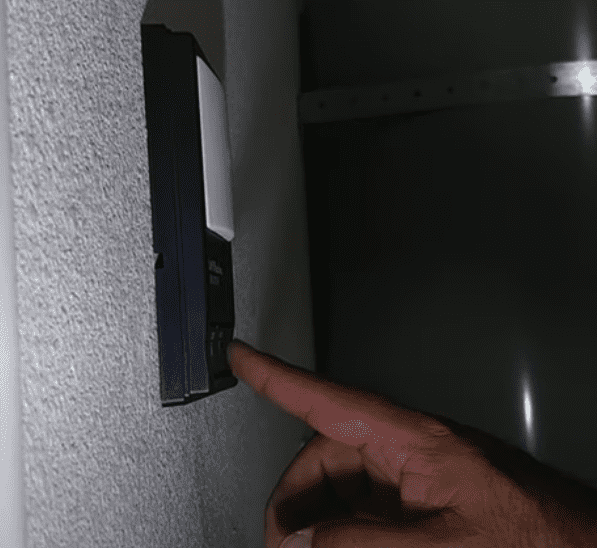
The garage door will start to go down, and as long as you’re still holding the button, it will continue to do so.
The sensors won’t kick in until you let go, which means you can get it to close fully just by holding on.
This is a temporary fix and doesn’t solve the root issue of your garage door sensors not working.
So, while it is possible to bypass the sensors this way, it’s best to have your garage door serviced as soon as possible.
2. Switch To Manual Operation
This may not be the option that excites you the most, but manually opening and closing your garage door is the most reliable way to bypass the sensors.
You won’t be able to use the motor or your open/close buttons anymore, but you will be able to use your garage while you’re waiting for a technician to come by!
Switching your garage door to manual is incredibly simple: just pull the cord that hangs down from the motor attached to the ceiling.
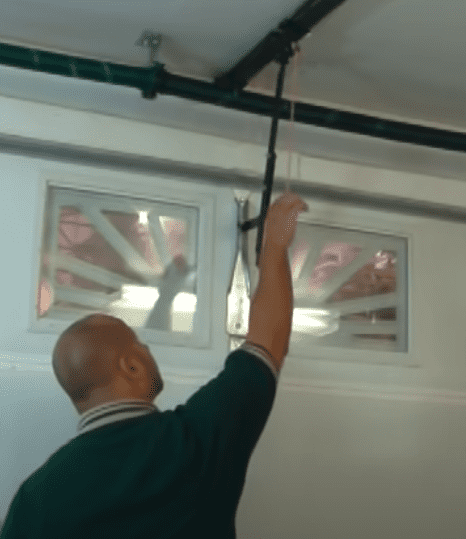
This releases the door from the chain that pulls it up/guides it down. Now, you’re able to lift and lower your garage door using the oldest tools known to man- the biceps!
Oh, and by the way- if your garage door is open or halfway open, you’ll want someone to hold onto it so it doesn’t go into a free fall when you pull the cord.
3. Hack the Sensor Alignment
I don’t really recommend this option, but I’ve seen it done successfully many times.
You will start by cutting your garage door sensor wires and completely removing them from the left and right sides of your garage door.
You’ll then rewire them directly to the overhead motor housing and mount them facing directly at one another using tape or some other mounting device.
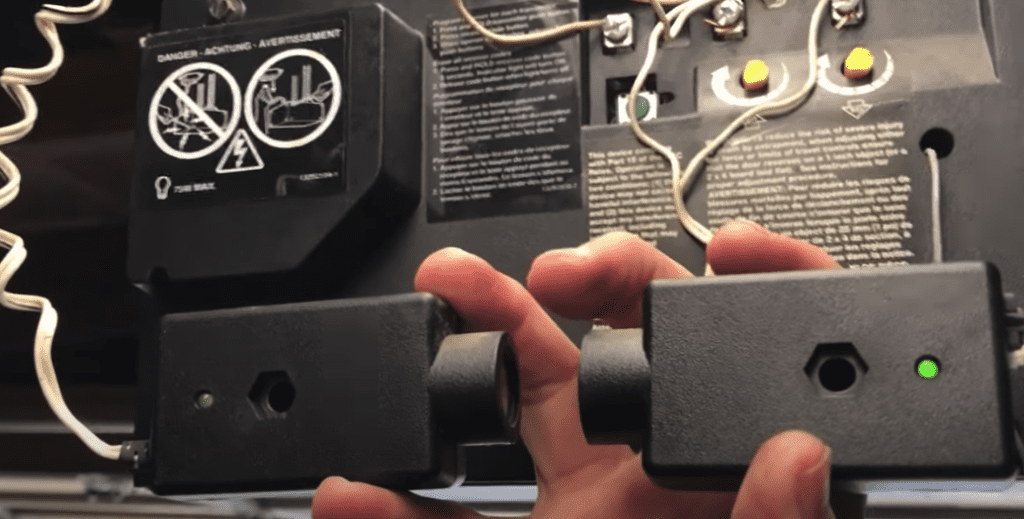
Your garage door opener will not work without these sensors connected and aligned. This hack allows you to bring the sensors within inches of one another, ensuring they stay aligned.
Obviously, this introduces several risks – namely your garage door will continue to close, even if something, or someone, gets in its way.
But if you’re really fed up with your opener not working, this might not seem like such a drastic step to take.
What is the Purpose of a Garage Door Sensor?
Your garage doors aren’t the thickest or heaviest “walls” in your house, but they are still very heavy.
If your garage door is closing and a small child or pet walks underneath it, they could be injured, trapped, or worse.
On top of that, they’re strong enough to do some damage to your car, bike, or other belongings if you accidentally place them in the way of the garage door.
Garage door sensors were invented and standardized to avoid these accidents.
If you press your garage door button and someone/something is within the sensor field, it will automatically stop and reverse the motion of the garage door.
These sensors are part of every garage door system and prevent accidents, injuries, and property damage every day.
Why Would You Need to Bypass a Garage Door Sensor?
Before you bypass your sensor, first consider why you’re doing it.
If you’re just doing it because your garbage cans get in the way of the sensor when stored in the garage, I suggest rethinking things.
Bypassing the garage door sensor without a good reason can put you, your family, and your property in danger.
It may also put you in hot water with your insurance company if something does happen, having your claim denied because you knowingly tampered with safety equipment.
It’s a bit like having your kitchen burn down, partly because you took the batteries out of your smoke detectors.
The only real reason you should be bypassing your garage door sensor is if it’s malfunctioning – preventing the garage door from closing even though there is nothing in the way.
In this case, you can and should bypass your sensor, but only temporarily – just until you’re able to fix the sensors.
Troubleshoot Your Sensor Instead of Bypassing
You should try to figure out why my garage door is acting up first, before trying to bypass it. Sometimes, you can get it working again in just a few minutes by using one of these troubleshooting methods!
1. Check for Obstructions
Okay, okay, I get it. You know this one. But, garage door sensors are a bit weird – sometimes, they’ll be triggered by something that isn’t technically in the way but is a bit too close.
Go out to your garage and clear out anything that’s within a foot of the sensors. Then, press the garage door button and see what happens.
If it’s still not working, the next step in troubleshooting is a must:
2. Check the Sensor Alignment
Garage door sensors are usually attached to the rails by a semi-flimsy metal bracket.
If the sensor gets bumped, it can become misaligned, either creating an inaccurate “sensor zone” or losing the connection with the other sensor entirely.
Take a look at both sensors. If one of them is bent at an angle, gently bend it back into position.
If this was the true culprit behind your garage door issues, you should find that everything will start working normally again.
3. Clean Your Sensors
This is something that most people never think of, but it has more of an effect than you’d think.
Dirty and dusty garage door sensors are far more likely to “get things wrong” than clean ones. Take a dry cloth and wipe down the sensors – sometimes, that’s all you need to do to get things working!
4. Check the Wiring
This is the only sensor issue that you probably can’t fix by yourself. If you notice that any of the wires in your garage door system are frayed, cracked, or broken, it could explain why the sensors are malfunctioning.
When you find issues with your wires, calling a garage door service company is likely your best option.
If you’re a skilled handyman or home electrician, you can have a go yourself, but most homeowners will be better off leaving this to a pro.
You may even be able to get the service paid for by the manufacturer – so it’s always worth digging out your owner’s manual to see what the warranty terms are. Many garage doors have long, generous warranties because they’re known for being very reliable.
5. Reset your Garage Door Opener
Often times the simplest solution is also the easiest. If you haven’t yet already, try resetting your garage door opener. It’s worth a shot.
Obviously, the exact steps you’ll need to take will vary depending on the type of garage door opener you own.
Keep in mind that you’ll probably have to reconnect your remotes and reset your passcode if you take this route.
FAQ: Bypassing a Garage Door Sensor
Can You Remove Garage Door Sensors?
Yes, but doing so will mean your garage door won’t work anymore unless it’s in manual operation. The sensors are there for a reason – taking them off will automatically disable most garage doors.
Can You Permanently Bypass Garage Door Sensors?
Nope – they are designed to be an integral part of your garage door system. There is no way to permanently bypass them, other than going into a manual operation mode.
Garage door sensors are installed to protect people and cars, and they are intentionally hard to get around.
If your garage door sensors are broken or malfunctioning, the best thing you can do is call a repair company. It’s far better to have a working garage door than it is to have one that you’re constantly having to jerry-rig every day.
Conclusion
The bad news is that there is no way to bypass your garage door sensors without making the use of your garage door more complicated.
Any method of bypassing them is best thought of as temporary – something you do while you wait for new parts or a repairman.
The good news is that you can bypass your sensor temporarily, allowing you to continue using your garage even though it needs to be repaired!
Good luck with your garage door sensors. Thanks for reading!

